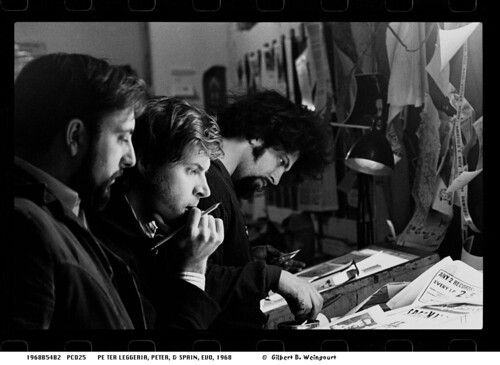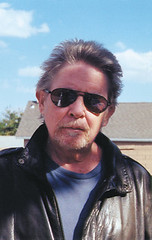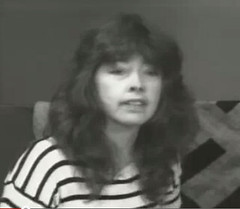Sunday afternoon the Third Street Crew of the New York City Hells Angels transformed Jamaica, Queens into a scene straight out of a post-apocalyptic motorcycle movie. Roaring in on low-slung chrome-plated Harleys, roughly 500 tattooed riders seemed right at home in the desolate industrial terrain that hosted the 13th annual St. Patrick’s Day Bash.
All the ingredients were in place for a great time: corned beef, cabbage, a comely brunette serving $4 drinks, a rock and roll band and not a police car in sight. But Angels run a tight ship and there were no orgiastic drunken brawls observed by The Local. In fact, when a female reporter dropped her fountain pen, three muscular bikers scrambled to retrieve it. Perfect gents for at least one moment in time.
By 2 p.m. U.S. military veterans and iron workers on hogs were still arriving in a steady stream to the Portuguese recreational club on Liberty Avenue near 148th Street, greeting fellow wheelers with brotherly hugs and man-talk. They paid $20 a piece for admission to the club, lining up for the hearty catered lunch and taking in music by Hugh Pool and Buddy Cage from New Riders of the Purple Sage.
It was hard to hear and maneuver amid the crush of hulking alpha males in leather and denim, but it was clear that union members with their own motorcycle clubs vastly outnumbered the Angels at the event. These included bikers belonging to Locals 46 and 580 of the New York Iron Workers (currently working on the new World Trade Center) and to the United Brotherhood of Carpenters, New York City Council District. “We ride with our own clubs but we have respect for the Angels,” said the carpenters’ motorcycle club president Joe Urbano.
Of course, any public event with the cultural cache of the Hells Angels is going to have a merchandising component behind it. Angels clothing, including some items for women, was for sale along with copies of the club’s 2012 calendar (you’ll have to decide for yourself how it stacks up against the Fire Department’s calendar).
Kathie Gimino of Staten Island hawked black t-shirts and assorted “badass embroidery.”
Read more…
Earlier this week, the Arthur L. Carter Journalism Institute launched “Blowing Minds: The East Village Other, the Rise of Underground Comix and the Alternative Press, 1965-72,” with a rousing discussion that’s now archived on the exhibit’s Website, along with new audio interviews with veterans of the Other. Over the course of seven weekend editions of The Local, we’ve heard from all but one of the EVO alumni who spoke on Tuesday’s panel. Here now, to cap off our special series, is the story of Peter Leggieri.
 Gil Weingourt Left to right: Peter Leggieri, Peter Mikalajunas, and Spain Rodriguez.
Gil Weingourt Left to right: Peter Leggieri, Peter Mikalajunas, and Spain Rodriguez.From the first day that I began working at The East Village Other, I was overcome by the sense that it was not only a newspaper but a strange and magical ship on a voyage with destiny. It seemed as though each issue printed was a new port of call, and the trip from one issue to the next, a new adventure. Many of EVO’s crew members expressed that same weird feeling – a sense of excitement and creative power.
And what a crew that was! No one was recruited. I don’t recall a resume ever being submitted. They all simply showed up and started working. EVO’s crew might just have been the greatest walk-on, pick-up team in the history of journalism. She was The Other but her staff of artists, poets, writers, photographers and musicians affectionately called her EVO. Her masthead bore a Mona Lisa eye. EVO created a cultural revolution and won the hearts and minds of a generation. She was the fastest ship in the Gutenberg Galaxy.
In the Beginning
I was the anonymous Other, the one editor-owner unknown to the public. I did not party. I did not schmooze with the literati or seek publicity. I had no time for such things. I worked seven days a week, 20 hours a day and, because of law school, I had to be sober. My friend, the poet John Godfrey, told me that I was afflicted with a Zen curse: a hermit condemned to be surrounded by people and events. That was certainly the case for me in the 1960s. Read more…
 Nancy Naglin Joe Kane
Nancy Naglin Joe KaneA veteran of The New York Ace, High Times, The New York Daily News and many other publications, Joe Kane describes how he got his start at EVO.
When I first migrated to Manhattan from Queens in 1970, it was with dreams of becoming a working scribe, preferably writing Beat fiction (unfortunately, one of the few things I was born too late for) and/or covering film in some capacity. Instead, I landed a boring temp job typing at a downtown insurance firm. During this time, somewhat happier circumstances led me to Screw, where the magazine’s then-art directors, Larry Brill and Les Waldstein, were going halves with publisher Al Goldstein on a new spin-off tab titled Screw X, a satirical variation on Screw (the height of redundancy, no?)
I auditioned for a writing/editing gig, with no guarantee Larry and Les would even get back to me. But a couple of days later, the phone rang in my East Sixth Street pad with promising news from the pair: Seems my work had been extolled by another of their writers, Dean Latimer, who told them it was “almost as good” (accent on almost) as his own stuff and that they should hire me straightaway.
For me, this was a frankly stunning turn of events. It so happened that Dean, whom I had never met, was already something of a personal hero; his “Decomposition” column and other writings were my favorite sections of The East Village Other. I considered Dean one of the most vivid and versatile writers I’d ever read anywhere, one equally adept at reportage, “think pieces,” memoir, criticism and totally devastating satire. That he had encouraging words for my fledgling efforts cheered me no end, and I resolved to thank my benefactor for his unsolicited largesse. Read more…
Coca Crystal (born Jackie Diamond) was EVO’s self-described “gatekeeper,” receptionist, sometime reporter and sometime model until the bitter end, when, as staff and resources dwindled, she became its defacto publisher (she financed the final two issues out of her own purse). Here, she describes how she got her start.
The first time I set foot in the EVO office, it was in the fall of 1969 and I had come to visit with a college friend, Barbara, who was EVO’s secretary.
The office was located on the third floor of the Fillmore East building on Second Avenue and Sixth Street. The place was a wreck. It was freezing, the garbage cans were overflowing, cigarette butts were everywhere, and the walls were covered in fabulous cartoons by the best in underground comix: R. Crumb, Kim Deitch, Spain Rodriguez, Yossarian, Shelton, Art Spiegelman, just to name a few. It was chaos, but a kind of cool chaos.
The office was in a frenzy to get copy ready for the typesetter, and I was asked if I could type. I said I could and was given the job of typing up the classifieds. I had never seen such weird ads. (“Dominant Iguana seeks submissive zebra,” sex ads, odd employment opportunities, legal advice for pot busts). I had to type while sitting on Allen Katzman’s lap (his idea), wearing my winter coat and gloves. When I had completed the classifieds I was told the other secretary, Marcia, was leaving and I could have her job if I wanted it. The pay was $35 a week. I took the job. Read more…







